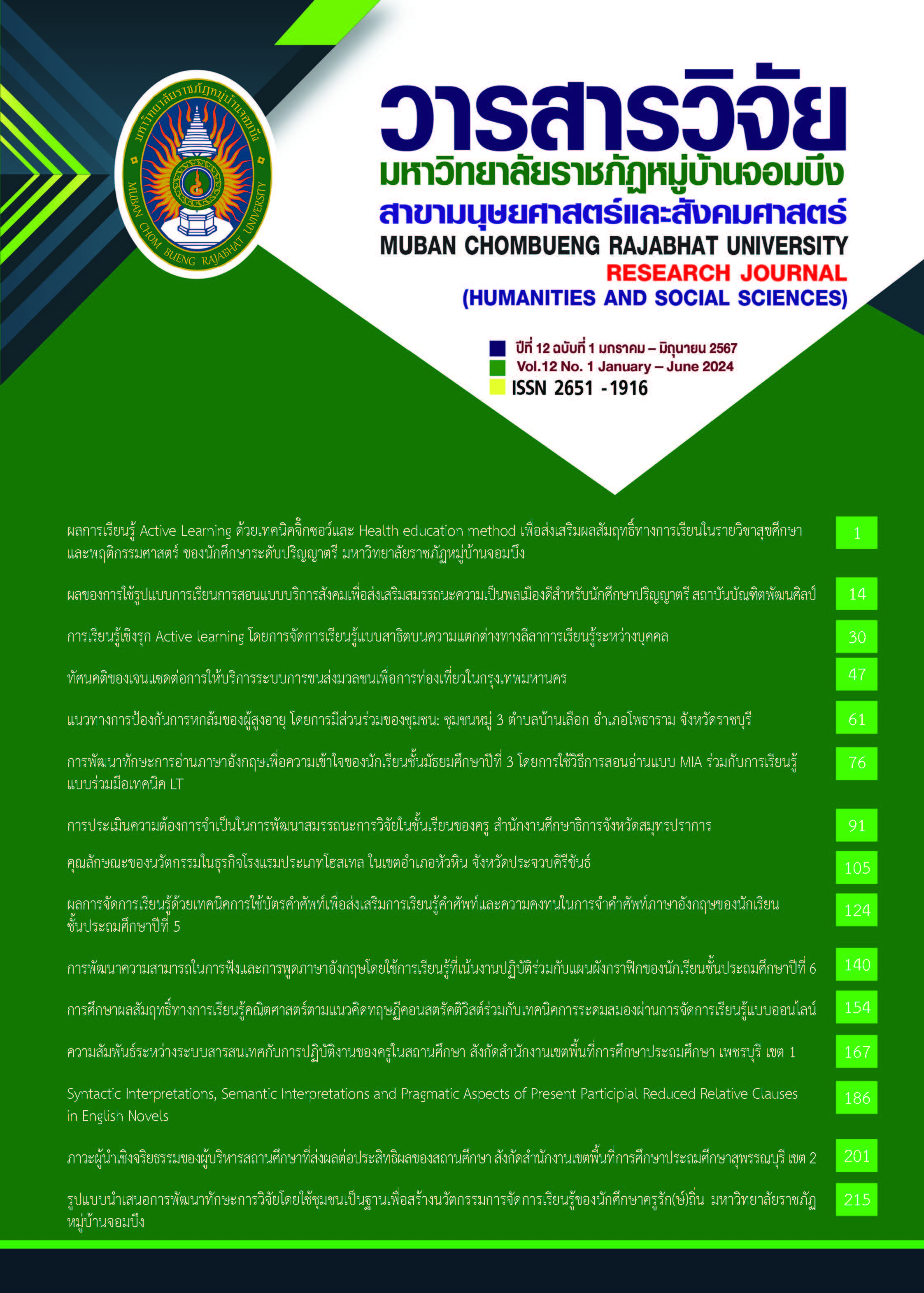แนวทางการป้องกันการหกล้มของผู้สูงอายุ โดยการมีส่วนร่วมของชุมชน: ชุมชนหมู่ 3 ตำบลบ้านเลือก อำเภอโพธาราม จังหวัดราชบุรี
คำสำคัญ:
ผู้สูงอายุ, การป้องกันการหกล้ม, การประเมินความเสี่ยงต่อการหกล้ม, การประเมินความเสี่ยงด้านสิ่งแวดล้อมในบ้านบทคัดย่อ
การวิจัยนี้มีวัตถุประสงค์เพื่อ 1) ประเมินความเสี่ยงการหกล้มของผู้สูงอายุในชุมชน และ 2) ศึกษาแนวทางการป้องกันการหกล้มของผู้สูงอายุในชุมชน การวิจัยมี 2 ขั้นตอน คือ 1) ประเมินความเสี่ยงต่อการหกล้ม กลุ่มตัวอย่าง คือ ผู้สูงอายุหมู่ 3 ตำบลบ้านเลือก อำเภอโพธาราม จังหวัดราชบุรี จำนวน 127 คน ด้วยวิธีเลือกแบบเจาะจง เครื่องมือวิจัย คือแบบประเมินความเสี่ยงต่อการหกล้มสำหรับผู้สูงอายุไทยที่อาศัยในชุมชน (THAI-FRAT) และแบบประเมินสภาพแวดล้อมในบ้านของผู้สูงอายุ 2) ศึกษาแนวทางการป้องกันการหกล้ม กลุ่มตัวอย่าง คือ ตัวแทนผู้สูงอายุ ญาติ ผู้นำชุมชน อสม. เจ้าหน้าสาธารณสุข จำนวน 30 คน ด้วยวิธีเลือกแบบเจาะจง ใช้กระบวนการรวมพลังสร้างอนาคต AIC สถิติที่ใช้คือ ค่าเฉลี่ย ส่วนเบี่ยงเบนมาตรฐาน ร้อยละ และวิเคราะห์ข้อมูลเชิงคุณภาพด้วยวิเคราะห์เนื้อหาและตีความตามประเด็นการประชุม
ผลการวิจัยพบว่า 1) มีผู้สูงอายุเสี่ยงต่อการหกล้ม ร้อยละ 26.77 ปัจจัยเสี่ยงคือ เพศหญิง การใช้ยา การมองเห็นบกพร่อง ร้อยละ 69.29, 61.42, 46.46 ตามลำดับ ความเสี่ยงด้านสิ่งแวดล้อมอยู่ในระดับสูงและปานกลาง ร้อยละ 0.79 และ 10.24 2) แนวทางการป้องกันการหกล้มมี 3 กลุ่ม คือ กลุ่มผู้สูงอายุและญาติ กลุ่มอสม.และเจ้าหน้าที่สาธารณสุข และกลุ่มผู้นำชุมชน ซึ่งแต่ละกลุ่มมีแนวทางการป้องกันการหกล้ม 4 ด้านคือ ด้านการส่งเสริมความรู้ ด้านการรักษาสุขภาพ ด้านการออกกำลังกาย และด้านการปรับปรุงสภาพแวดล้อม สามารถนำผลการวิจัยไปประยุกต์ใช้กับชุมชนอื่น ๆ เพื่อวางแผนป้องกันและลดอัตราการเกิดการหกล้มของผู้สูงอายุในชุมชนตามบริบทของชุมชนนั้น ๆ
เอกสารอ้างอิง
จารุภา เลขทิพย์, ธีระ วรธนารัตน์, ศักรินทร์ ภูผานิล และศราวุธ ลาภมณีย์. (2562). ปัจจัยเสี่ยงต่อการหกล้มในผู้สูงอายุ. J Med Health Sci, 26 (1), 85-103.
จินตนา อาจสันเที๊ยะและพรนภา คำพราว. (2557). รูปแบบการดูแลสำหรับผู้สูงอายุในชุมชน วารสารพยาบาลทหารบก, 15 (3), 123-127.
จุฬาภรณ์ โสตะ. (2554). แนวคิด ทฤษฎี และการประยุกต์ใช้เพื่อการพัฒนาพฤติกรรมสุขภาพ. ขอนแก่น : คณะสาธารณสุขศาสตร์ มหาวิทยาลัยขอนแก่น.
นงนุช วงศ์สว่าง, ดนุลดา จีนขาวขำ, ชลธิชา บุญศิริ, สุรินทร์ มีลาบล้น, จารุนันท์ สมบูรณ์สิทธิ์, เบญจมาศ คำธนะ และธานี กล่อมใจ. (2560). ความเสี่ยงด้านสิ่งแวดล้อมในบ้านต่อการพลัดตกหกล้มและอุบัติการณ์การพลัดตกหกล้มของผู้สูงอายุ. วารสารมหาวิทยาลัยศิลปกร ฉบับภาษาไทย สาขามนุษยศาสตร์ สังคมศาสตร์ และศิลปะ, 10 (3), 2492-2506.
ไพบูลย์ วัฒนศิริธรรม และวิเชียร ศรีลูกหว้า. (2552). เทคนิคการรวมพลังสร้างอนาคต. ค้นเมื่อ ธันวาคม 2, 2563 จาก https://www.gotoknow.org/posts/260442
โรงพยาบาลส่งเสริมสุขภาพตำบลบ้านเลือก. (2562) รายงานข้อมูล จปฐ. ประชากร บ้านขนุน ตำบลบ้านเลือก อำเภอโพธาราม จังหวัดราชบุรี 2562. ราชบุรี : ผู้แต่ง.
ลัดดา (เถียมวงศ์) เพชรประสมกูล, จิตติมา ทมาภิรัต, วันทนา มณีศรีวงศ์กุล และสุทธิชัย จิตะพันธ์กุล. (2551). เครื่องมือประเมินความเสี่ยงต่อการหกล้มสำหรับผู้สูงอายุในชุมชน. J Med Assoc Thai, 91 (12), 1823-1832.
วิทยา วาโย, นารีรัตน์ จิตรมนตรี และวิราพรรณ วิโรจน์รัตน์. (2560). ผลของโปรแกรมป้องกันการหกล้ม แบบสหปัจจัยต่อพฤติกรรมการป้องกันการหกล้มของผู้สูงอายุในชุมชน. วารสารการพยาบาลและการดูแลสุขภาพ. 35 (2), 25-33.
ศศิพัฒน์ ยอดเพชร. (2553). ครอบครัวและผู้สูงอายุ. ใน ชื่นตา วิชชาวุธ, นภาพร ชโยวรรณ, ยุพา วงศ์ไชย, ประคอง อินทรสมบัติ, นันทศักดิ์ ธรรมานวัตร (บรรณาธิการ), การทบทวนและสังเคราะห์องค์ความรู้ผู้สูงอายุไทย พ.ศ. 2545-2550 (193-223). กรุงเทพฯ : มูลนิธิสถาบันพัฒนาผู้สูงอายุไทย.
สำนักโรคไม่ติดต่อ กรมควบคุมโรค กระทรวงสาธารณสุข. (2558). รายงานประจำปี 2558. กรุงเทพฯ : องค์การสงเคราะห์ทหารผ่านศึก.
Robert, V. Krejcie & Daryle, W. Morgan. (1970). Determining Sample Size for Research. Activities. Educational and Psychological Measurment, 30 (3), 607-610.
Renfro, M.,O. & Fehrer, S.(2011). Multifactorial screening for fall risk in community-dwelling older adults in the primary care office: development of the fall risk assessment & screening tool. J Geriatr Phys Thre, 34 (4), 174-183.
ดาวน์โหลด
เผยแพร่แล้ว
รูปแบบการอ้างอิง
ฉบับ
ประเภทบทความ
สัญญาอนุญาต
ลิขสิทธิ์ (c) 2024 วารสารวิจัยมหาวิทยาลัยราชภัฏหมู่บ้านจอมบึง สาขามนุษยศาสตร์และสังคมศาสตร์

อนุญาตภายใต้เงื่อนไข Creative Commons Attribution-NonCommercial-NoDerivatives 4.0 International License.
วารสาร TCI อยู่ภายใต้การอนุญาต Creative Commons Attribution-NonCommercial-NoDerivatives 4.0 International (CC BY-NC-ND 4.0) เว้นแต่จะรุบุไว้เป็นอย่างอื่นโปรดอ่านหน้านโยบายของเราสำหรับข้อมูลเพิ่มเติมเกี่ยวกับการเช้าถึงแบบเปิด ลิขสิทธิ์ และการอนุญาต



